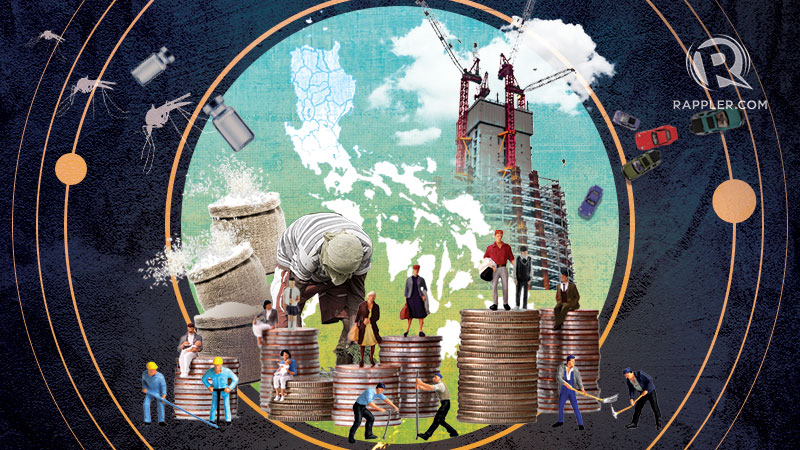

As the new decade dawns, let’s take a moment to appreciate how much we’ve progressed in the past 10 years.
You may not have noticed, but most Filipinos’ incomes and living standards have grown considerably over the decades – to the point that, in the 2010s, at least where the economy is concerned, we never had it so good.
This is not to say, of course, that all is well. We still need to catch up with some of our ASEAN neighbors, and many government policies threaten to undo rather than sustain some of our hard-earned gains.
In this piece let’s track our progress in the 2010s and identify threats to future progress in the 2020s.
Stellar growth
First and foremost, Filipinos’ incomes have grown quite a lot as measured by gross domestic product or GDP per person.
Figure 1 shows that in 2010 the average Filipino earned about P61,572 a year. But in 2018 (the latest data we have) that grew by a sizable 40% to P86,334.
Roughly the same increase can be seen if we use instead gross national income or GNI per person, which includes the incomes of overseas Filipino workers (OFWs).
Figure 1.
Higher incomes were occasioned by stellar growth. In fact, this decade our GDP grew by an average yearly rate of 6.3% – the fastest since the 1950s. This catapulted us as one of the fastest-growing economies in Asia and the world.
We care about our nation’s overall income not because we believe it can solve all our problems – it obviously can’t – but rather because a larger national income allows us, at least in principle, to enjoy more goods and services. As Jane Austen once said, “A large income is the best recipe for happiness I ever heard of.”
Higher incomes mean little if prices are skyrocketing. Luckily, in the past 10 years, government managed to keep inflation low and stable – except in 2018 when rice prices and the TRAIN law’s excise taxes stoked inflation.
As our incomes rose, joblessness and poverty abated. Unemployment and underemployment reached all-time lows this year (Figure 2) and – rather surprisingly – poverty dropped quite steeply: 1 in 4 Filipinos were poor in 2009, but only 1 in 6 were poor in 2018.
Figure 2.
Drivers of growth
What brought about this tide of prosperity in the 2010s?
Throughout the 2010s our economy was still driven largely by individuals and households’ consumption. This is evidenced by, say, the proliferation of malls and private vehicles.
Such consumption was buoyed by robust inflows of remittances from OFWs, as well as incomes from industries like business process outsourcing (BPO).
But more notably, this decade we spent more on investment goods such as construction machinery and telecom equipment. This is crucial since investment goods fuel future growth.
Industry – which comprises manufacturing, construction, and utilities – also contributed more to growth this decade relative to other sectors, somehow chipping away at the predominance of services.
Our young and swelling workforce has also been a key driver of growth, especially with the so-called “demographic dividend.” With our workforce set to peak in the next 3 decades, the combined productivity of our workers is expected to boost consumption, investment, and saving – hence, growth – for many more years.
Threats to growth
The 2010s saw remarkable growth, and the main challenge for us in the 2020s is how to sustain – even best – it. Unfortunately, threats to growth abound.
For starters, investment’s contribution to growth surprisingly shrank in 2019, the first time in 7 years.
Foreign direct investments also dropped since middle of 2018, and this could worsen with an impending bill that aims to rationalize investment incentives. The Duterte government’s capricious policies and unreasonable attacks on certain big businesses are also spooking investors.
Severe traffic – especially in Metro Manila – is also taking a huge toll on growth. Government responded by initiating a massive infrastructure program called Build, Build, Build, but so far its projects are far from completion.
Water shortages also loom as the government fails to install new bulk water sources to meet rising demand.
Lamentably, agriculture stagnated in the past decade, and the recent Rice Tariffication Act depressed rice prices to the detriment of rice farmers nationwide.
Abroad, many countries are bracing for an economic slowdown. Escalating trade tensions between the US and China are likely to disrupt Philippine exports and imports, weak as they are.
Lingering tensions in the West Philippine Sea also jeopardize our national security and our plentiful natural resources there like land, oil, corals, and fish.
Beyond growth
Economic growth is not the end-all and be-all of development. Progress goes well beyond having a higher GDP.
Although more Filipinos live longer lives now than ever before (Figure 3), we also recently saw the rise of measles, dengue, and polio outbreaks since many parents hesitate to have their children vaccinated, fearful of Dengvaxia.
Figure 3.
We also have an education crisis staring us in the face, as suggested by the dismal results of the PISA 2018 study. Poorly educated workers may be hardest hit by rising automation and the Fourth Industrial Revolution, among other emerging trends.
Duterte signed universal healthcare and free college tuition to improve our people’s health and education, but merely passing these laws isn’t enough. Universal healthcare still lacks funds and many fear free college tuition will be largely regressive (pro-rich).
Key reforms by the past administration – namely reproductive health and K-12 – also produced mixed results. To this day conservative lawmakers are blocking funds for certain artificial contraceptives, and most public schools have been caught ill-prepared for the roll-out of K-12.
Economic growth also failed to lift all boats.
Income inequality – roughly the disparity between the incomes of the rich and poor – is declining but very slowly. The Autonomous Region in Muslim Mindanao (now formally known as BARMM) also continues to be left behind vis-à-vis other regions. And Duterte’s war on drugs is really a war on the poor (possibly negating some of the government’s key social protection programs).
Finally, climate change threatens all our futures. By 2050, a mere 30 years from now, large swathes of Metro Manila (and other key cities) risk being submerged by rising sea levels. Despite this clear danger, the Duterte government chose to turn its back on all climate change negotiations.
Sustaining growth
Although we can’t often see or feel the march of progress, there’s a lot to be thankful for in the 2010s.
In that decade lots more Filipinos became remarkably more prosperous and healthy, so much so that the 2010s might be considered our economy’s true “golden age.”
Coming into the 2020s, however, the main challenge for all of us is how to sustain such growth and keep at bay its many threats.
It’s a daunting task, and we all have our work cut out for us. – Rappler.com
The author is a PhD candidate at the UP School of Economics. His views are independent of the views of his affiliations. Thanks to Jeff Arapoc for useful comments and suggestions. Follow JC on Twitter (@jcpunongbayan) and Usapang Econ (usapangecon.com).